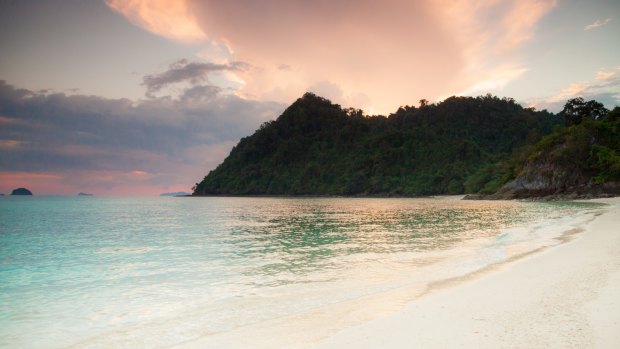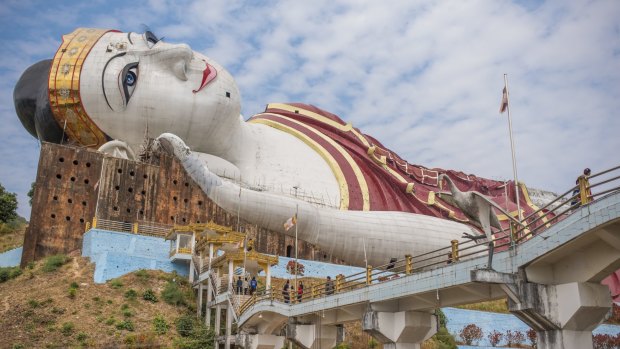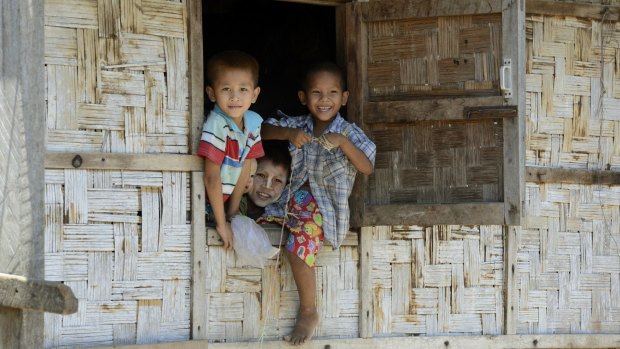This was published 4 years ago
History, temples and sea gypsies in the Mergui Islands and southern Myanmar
By John Borthwick

A deserted beach in the Mergui Islands.Credit: iStock
Two Moken "sea gypsy" girls are heading our way, a mile out to sea and walking on water. I grab the binoculars. In fact, they're standing in dugout canoes, propelling themselves rapidly forward with upright oars.
Reaching our motor yacht, Andaman Explorer, the teenage pair bobs alongside, swapping jokes and gossip with the crew. After downing soft drinks and a few snacks they're off home, gliding across the swell, back to Jarlan Island in the remote Mergui (pronounced Mer-guay) Archipelago.

Win Sein Taw Ya, the world's largest Reclining Buddha, stretches for almost the length of two football fields Credit: iStock
Myanmar's Andaman coast runs 1000 kilometres from Yangon down to the country's southernmost tip, Kawthaung. We're on a 10-day cruise south between the two ports but before we reach the Mergui islands we get to explore a coast that is peppered with the remnants of old British Burma.
Mawlamyine, previously known as Moulmein, was the original capital of British Burma. A steamy, sprawling port on the Salween River six hours' drive from the capital, it still bristles with ancient pagodas but is far from stuck in the past. As local author Ma Thanegi quips wryly, "Moulmein looks like a city on the verge of sophistication."
Two of the England's most famed writers immortalised Moulmein, although from very different perspectives. British Bulldog laureate Rudyard Kipling spent just half a day here in 1889 yet penned a regret-laden ballad, Mandalay that has endured as an anomalous paen to love, the East and soldiering. Smitten by a local beauty, Kipling wrote: By the old Moulmein Pagoda, lookin' lazy at the sea There's a Burma girl a-settin', and I know she thinks o' me ..."

Childern in the historic city of Myeik, in Myanmar's south.Credit: urf
Perhaps she did, perhaps she didn't. The more pressing issue for the poet was that he had a totally prosaic boat to catch: "Only the fact of the steamer departing at noon prevented me from staying at Moulmein forever," he wrote. Well, perhaps.
Decades later a young English policeman, Eric Blair, later famed as George Orwell, author of 1984 and Animal Farm, was posted to Moulmein. He loved Burma but loathed his own tribe's behaviour there. As the Empire's anti-scribe, in his memoir Burmese Days Orwell sketched a damning portrait of colonial "society" in the 1920s: "Year after year you sit in Kipling-haunted little Clubs, whisky to the right of you … listening while Colonel Bodger develops his theory that these Nationalists should be boiled in oil."
Our off-ship excursions take us through a scrubby landscape dominated by an odd real estate pair, military bases and Buddhist monasteries, with their huge holdings separated by rubber plantations and occasional towns. At Thanbyuzayat we come to a World War II cemetery where 1335 Australian troops are buried, along with many more allied POWs. This poignant field of headstones marks the northern terminus of Imperial Japan's monstrous Thailand—Burma "Death Railway".
There are lighter sites along the way. At Win Sein Taw Ya, the world's largest Reclining Buddha stretches for almost the length of two football fields (with a second giant being built facing him). Further on, we swim at Maungmagan, a vast, sandy arc acclaimed as the country's longest beach. Its waters are like tepid tea but the sunset's vivid light show might have had Kipling musing, a la Mandalay, "An' the sun goes down like thunder into India 'cross the Bay".
The standout town here is historic Myeik (aka Mergui) where the main drag is still like a reliquary of the Burmese Raj. Civic edifices, godown warehouses, churches and teak shop-houses — some crumbling, others well restored — line the busy main street. A sign announces "Old Boys Tennis Club (Established 1924)" while several formerly Indian-owned mansions echo the bitter Burmese epithet of the era: "The British hold us down while the Indians pick our pockets."
The 800 islands of the Mergui Archipelago spill for 500 kilometres down Myanmar's far south coast. Off-limits to foreigners for half a century following independence in 1948, they remain barely populated except for fishing villages and the increasingly marginalised Moken sea gypsies.
Our boat weaves between forested islands where we snorkel or kayak off empty beaches with emerald shallows. There are macaques in the trees and civets' prints in the sand. Brahminy kites circle like sentinels but the hornbills remain ever elusive.
I sailed here once before and recall a crewman saying, "Some of this archipelago is so unmapped that at times we've been 100 metres off a beautiful island that doesn't even exist on our chart." It's good to see that there still have been few "improvements" on land. By night, however, the horizon is ablaze with the green lure lights of vastly more fishing boats, legal and illegal, ravenously scooping up squid.
There is a significant Australian connection to these islands. In 1935 pioneer Australian aviator Sir Charles Kingsford Smith and his co-pilot disappeared in these waters while attempting the flying record from England to Australia. Smithy's plane, the Lady Southern Cross was at first thought to have come down in the Mergui Islands. The search later switched further north but the wreck was never found.
On Lun Lun Island we go ashore at Port Maria, a village of ethnic Karen refugees from the mainland. The mayor, Mrs Naw Pan Ngwe Phyu welcomes us to the neat and disciplined settlement of around 100 families, all Baptist Christians, where the local government is run not by Yangon but the independence-minded Karen National Union. One of us presents the mayor with a large package of exercise books and writing materials for the village school. She happily accepts them, and then apologises, "But I have nothing to give back to you — would you like to eat mangoes instead?" She doesn't need to ask twice.
These Andaman Shangri-La realm sees around 3000 visitors a year (compared to Phuket on the same coast with nine million arrivals) but there are no chain resorts or condos. So far only three resorts have been established, on separate islands. Two are upmarket, boutique operations, Wa Ale Resort and Awei Pila, while Boulder Bay Eco-Resort is less pricey.
Among the few ways to sail the islands is by a live-aboard boat like the converted Burmese junk, Sea Gipsy or the elegant yachts of the Burma Boating fleet, all of which depart from Kawthaung. Sadly, Pandaw's Andaman Explorer no longer operates here.
Coxcombe Island near the tail-end of the archipelago is a koh hong, or "room island", with its walled central lagoon open to the sky above. Entering the lagoon under a low coral archway is often difficult but this is our lucky day. "I've been here eight times and for four of those we couldn't get in," says our ship's purser, Maung Naing. The tide and swell are both low and with a metre of headroom to spare we swim or paddle kayaks into the wide, heart-shaped lagoon.
There are pristine corals (increasingly hard to find even in these once untrammeled islands), soaring, jungle-clad limestone walls and, when we settle down from our first gleeful enthusiasms, a cone of glorious silence.
FIVE THINGS TO DO IN MYANMAR'S SOUTH
VISIT KAWTHAUNG
From Ranong, Thailand, it's a 30-minute trip across the Kraburi River to Kawthaung, starting point for Mergui cruises, excursions and resort transfers. Explore Kawthaung by tuk-tuk or visit Andaman Club casino.
SEE THE ARCHIPELAGO UP CLOSE
Visit the islands by sea kayak with Southern Sea Adventures, luxury yacht with Burma Boating or safari boat Sea Gipsy. See southernseaventures.com; burmaboating.com; islandsafarimergui.com
STAY IN A RESORT
There are three resorts in the southern Mergui islands, two being boutique properties, Wa Ale Resort and Awei Pila, plus the more basic Boulder Bay Eco-Resort. See waaleresort.com; aweipila.com; boulderasia.com
EXPLORE LAMPI MARINE PARK
Myanmar's only marine national park, Lampi Island, is at the heart of the archipelago and is dense with rainforests, mangroves and bird species.
VISIT RANONG
Enroute to a Mergui trip, explore Ranong, one of Thailand's smallest regional capitals. It is under-touristed, has excellent hot springs and daily flights to Bangkok.
TRIP NOTES
Bangkok Airways flies from Bangkok to Yangon and local buses serve much of the Myanmar coast. See bangkokair.com; myanmarbusticket.com
CRUISE
John Borthwick was a guest of Pandaw Cruises.
Sign up for the Traveller Deals newsletter
Get exclusive travel deals delivered straight to your inbox. Sign up now.